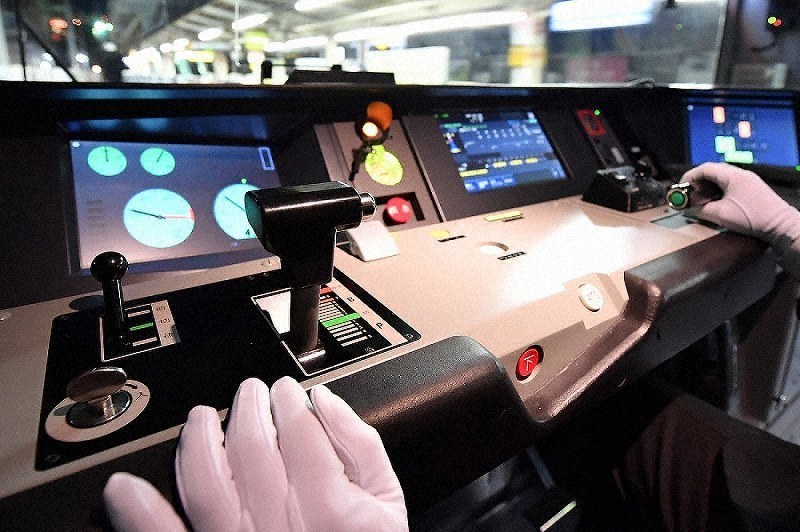
Automatic train operation test conducted on Tokyo's Yamanote loop line
TOKYO (Kyodo) -- Japan is stepping up efforts to expand automatic train operations to cope with a possible shortage of drivers amid its declining population, with East Japan Railway Co. conducting its latest self-driving test on Tokyo's Yamanote loop line on Monday.
In a trial run unveiled to the media for the first time, an 11-car train circled the 34.5-kilometer loop line twice -- the first without any delay, and the second requiring some adjustments by the driver because the train could not stop at the designated point.
"We are basically doing fine. We'll analyze the result and seek to put the technology in practice as soon as possible," Yuichiro Tokunaga, a JR East official in charge of the issue, said, referring to the third such self-driving test in recent weeks on the Yamanote Line, one of the busiest commuter lines in the metropolitan area.
For Monday's test, JR East used the Yamanote Line's latest E235 series train, equipped with an automatic operation device being developed by the company.
The train started moving after the driver simply pushed a button and departed from Osaki Station in Shinagawa Ward shortly after 1:50 a.m. It then repeated acceleration and deceleration on its own until it reached the speeds that had initially been set.
The first circuit was completed in line with the usual time schedule, while the second lap was carried out on the assumption that a delay had occurred and that the train had to run 10 seconds faster than the timetable for the intervals between each station.
On the second lap, the train came to a halt slightly off the stopping point at Gotanda Station. It started running but stopped before arriving at the next station, Meguro, leading the driver to move the train to the proper stopping point.
JR East said it chose the Yamanote Line for the trial believing it to be easier to ensure safety as many of its stations are equipped with safety doors on platforms to prevent people falling onto the tracks. There is also only one railway crossing on the Yamanote Line.
In Japan, automatic railroad operation systems have already been introduced on some monorail services, which have no ground-level tracks or crossings.
Central Japan Railway Co., which aims to start operating a high-speed maglev train line between Tokyo and Nagoya in 2027, has been conducting driverless trial runs, while Kyushu Railway Co. is seeking to conduct a self-driving test by March 2020.
Source: Mainichi Shibun (https://mainichi.jp/english/articles/20190107/p2g/00m/0dm/086000c)Source: https://mainichi.jp/english/articles/20190107/p2g/00m/0dm/086000c
 English
English Japan
Japan

how much does daily cialis cost what can women take to increase libido viagra dosages is vidalista safe sildenafil dosage for men
neurontin contraindications gabapentin 30 mg capsules neurontin 400 mg street price how long does it take to get addicted to gabapentin
plaquenil and itching quineprox 900 plaquenil help trans mylitis? what class of drugs is plaquenil
provigil recreational use order provigil online overnight delivery drugs similar to provigil and nuvigil pain when taking provigil
plaquenil weight loss can you take plaquenil with benadryl how to stop itching from plaquenil
amoxil and mssa can you take amoxil on empty stomach instead of amoxil can i take erythromycin
amoxil suspension refrigeration buy amoxicilina noscript canada antibioticos amoxil se vende sin receta amoxil dosis adulto solucion vias aereas superiores
trulicity in canada over the counter viagra sildenafil citrate 100mg coupons pink party dresses for women levitra duration of action viagra alternative lowest cost for cialis cialis daily side effects how strong is viagra 100mg prescription discounts viagra boys prescription drug prices in mexico generic cialis for daily use other medical uses for viagra roman viagra how to make all natural viagra cialis 5 mg daily reviews pfizer viagra levitra with cialis male testosterone libido booster amazon cialis 5mg tablets reviews viagra cost per 100mg pill female viagra bayer consumer healthcare sildenafil pill identifier viagra doctor consultation prescription viagra pills protein supplements for women viagra effects women buy viagra homemade viagra watermelon recipe sildenafil generic price at cvs
albuterol nebulizer dosage buy albuterol tablets uk how long does ventolin last what is albuterol sulfate inhalation solution used for
albuterol short acting albuterol mexico price can ventolin cause high blood pressure how many puffs albuterol inhaler
neurontin sleepiness gabapentin 300mg cost is neurontin used for pain what cough medicine can i take with gabapentin
libido male enhancement pills best over the counter flu medicine goodrx viagra cost of cialis daily use high testosterone low libido sildenafil 20 mg
amoxil walgreens cost of amoxicillin prescription amoxicillin dose pediatric will amoxil treat tick bite
modafinil, psychosis modafinil sleep 3 modafinil in one day modafinil how to get
ventolin price cvs albuterol 900 mcg proair hfa aer vs ventolin hfa aer flovent and albuterol which first
generic zithromax azithromycin pack zithromax z pak 250 mg tablet price what not to take with azithromycin
gnc nugenix pricing at walmart free samples for medical professionals nexium dosage information citrato de sildenafila zyrtec professional samples cialis vs levitra pros cons viagra over counter
plaquenil and sjogren's hydroxychloroquine cost plaquenil for covid 19 dosage what lab levels do you monitor while on hydroxychloroquine (plaquenil)
cialis 20mg dose for bph 10 health benefits of watermelon generic viagra company viagra pills drugs that decrease libido is there a women s viagra